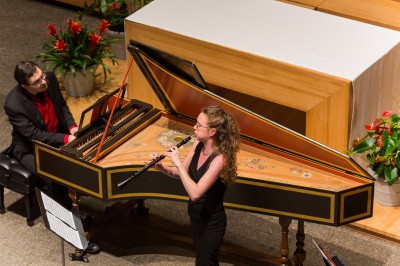Book the Sebastians

The Sebastians love touring outside of NYC, in combinations big and small. Below you can see some examples of past programs we have brought to concert series as well as some ideas for future programming. We can also curate a new program for your venue, series, or special event if you have a direction that seems more appealing. Contact us to start a conversation about bringing the Sebastians to you!
Karl Hinze, Managing Director
Email: music@sebastians.org
Phone: 262-345-BACH (2224)
Click here for our complete Press Kit including images, press quotes, concert bio and more.
Sample Programs
The Six Brandenburg Concerti
(19–20 musicians)
The Sebastians present J.S. Bach’s six Brandenburg Concertos, a cornerstone of the baroque orchestral repertoire. These works highlight a variety of instrumental combinations, contrapuntal ingenuity, and dynamic contrasts. Performed with historical insight and precision, this program showcases Bach’s inventive approach to form, texture, and virtuosity, offering a complete exploration of these seminal concertos in one program—featuring virtuosic solos for natural trumpet, recorders, traverso, celli, violas da gamba, solo harpsichord, violins, violas, and more!
Baroque Conversations
(12–14 musicians)
This program explores the dynamic interplay of Baroque concertos, featuring works by Bach, Telemann, and Vivaldi. Telemann’s Concerto in A major from Tafelmusik highlights elegant contrasts, while Bach’s Brandenburg Concertos nos. 3, 5, and 6 showcase diverse instrumental colors. Vivaldi’s Concerto for Two Cellos adds a striking virtuoso dialogue to this rich and varied program.
‘Tis the Season
(7–14 musicians)
The Sebastians bring Vivaldi’s Four Seasons to life with their signature energy and virtuosity, featuring the Sebastians’ “fleet-fingered, passionate” (The New York Times) violinists. The program also includes one of Telemann’s rarely heard concerti for four violins without continuo.
The Uncommon Violino Piccolo
(4 singers, 13 instrumentalists)
The violino piccolo, the highest-pitched instrument of the baroque string family, is rarely heard today—but this program brings it to the forefront. Johann Sebastian Bach’s Cantata 140 and Brandenburg Concerto No. 1 feature dazzling solo parts for the instrument, usually played on modern violins but now restored to their original brilliance. Works by Johann Pfeiffer and Johann Joseph Fux reveal the violino piccolo’s lyrical and expressive capabilities.
The Vivaldi Project
(10 musicians)
To mark the 300th anniversary of Vivaldi’s L’Estro Armonico (1711), the Sebastians commissioned composer Robert Honstein to write a companion suite. The result is a dialogue between baroque and contemporary styles, imagining the sound of Venice the children of the Ospedale might have heard in bed at night—boats creaking, far-away minstrels, and more.
The Bach Family
(9–12 musicians)
A celebration of one of music’s most influential families, this program showcases chamber and orchestral works by J.S. Bach and his sons Carl Philipp Emanuel Bach, Johann Christian Bach, and Wilhelm Friedemann Bach. Exploring the connections and contrasts between their styles, the concert highlights how each generation carried forward—and transformed—the Baroque tradition.
Les Nations
(4–8 musicians)
Baroque composers embraced national styles while also borrowing from one another. This program explores these cross-cultural influences, from Corelli’s Italian sound to Couperin’s fusion of French and Italian elements, and from Telemann’s blend of Italian and Polish styles to the English elegance of William Boyce.
Bach Cantatas 188 & 140
(4 singers, 10 instrumentalists)
These two cantatas by J.S. Bach shine in an intimate, one-per-part setting. Wachet auf, BWV 140, is beloved for its luminous chorales, while Ich habe meine Zuversicht, BWV 188, is more introspective and virtuosic. This program can be performed without intermission or expanded with contrasting pieces by Handel, Rosenmüller, Erlebach, and Telemann.
Venetian Romance, Roman Vigor
(4 musicians)
Tracing the evolution of the trio sonata, this program moves from the lyrical Venetian dances of Dario Castello and Tarquinio Merula to the bold and structured Roman school of Giovanni Battista Fontana and Corelli. The journey ends with Vivaldi’s electrifying Folia.
Buxtehude and Biber
(5 musicians)
Contrasting the sacred and secular worlds of the Baroque, this program explores the music of Dieterich Buxtehude and Heinrich Ignaz Franz Biber. The pairing—church vs. court, north vs. south—creates a compelling dialogue of styles. This program can include Buxtehude cantatas with the addition of singers.
Over the Alps
(2–4 musicians)
This program traces the spread of Italian musical styles across Europe, from the expressive sonatas of 17th-century Italy to their transformation in 18th-century Austria and Germany. Featuring works by Bach, Biber, Corelli, Fontana, Froberger, Handel, Telemann, and Vivaldi.
Bach and Forth
(3–4 musicians)
A journey through the German baroque trio sonata, this program places Bach alongside his predecessors and contemporaries, including Handel, Buxtehude, Rosenmüller, Erlebach, and Telemann, exploring the exchange of ideas between German composers.
Orfeo del Violino
(3–4 musicians)
Corelli revolutionized violin playing. This program explores his legacy, from his Roman predecessors—Colista, Frescobaldi, and Stradella—to his successors, including Handel, Vivaldi, and Couperin. It culminates in Couperin’s L’Apothéose de Corelli.
